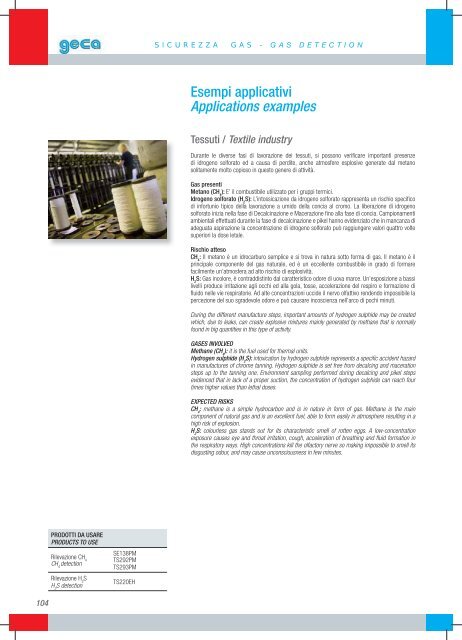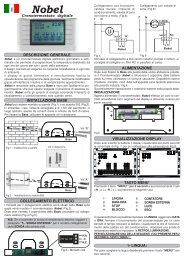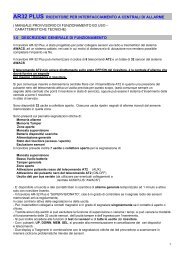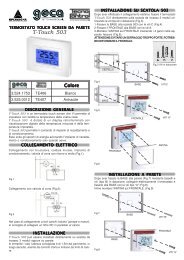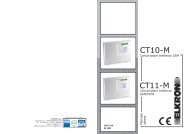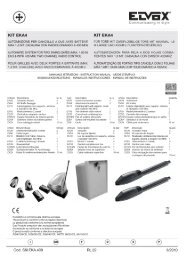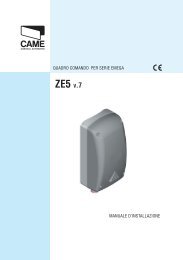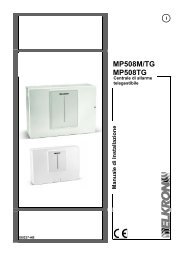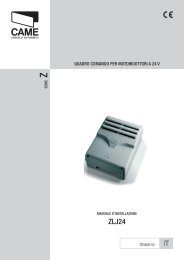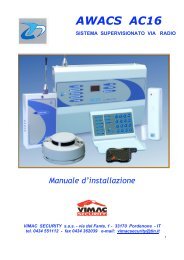Applications examples - Mgelettroforniture
Applications examples - Mgelettroforniture
Applications examples - Mgelettroforniture
You also want an ePaper? Increase the reach of your titles
YUMPU automatically turns print PDFs into web optimized ePapers that Google loves.
SICUREZZA<br />
GAS - GAS DETECTION<br />
Esempi applicativi<br />
<strong>Applications</strong> <strong>examples</strong><br />
Tessuti / Textile industry<br />
Durante le diverse fasi di lavorazione dei tessuti, si possono verificare importanti presenze<br />
di idrogeno solforato ed a causa di perdite, anche atmosfere esplosive generate dal metano<br />
solitamente molto copioso in questo genere di attività.<br />
Gas presenti<br />
Metano (CH 4<br />
): E’ il combustibile utilizzato per i gruppi termici.<br />
Idrogeno solforato (H 2<br />
S): L’intossicazione da idrogeno solforato rappresenta un rischio specifico<br />
di infortunio tipico della lavorazione a umido della concia al cromo. La liberazione di idrogeno<br />
solforato inizia nella fase di Decalcinazione e Macerazione fino alla fase di concia. Campionamenti<br />
ambientali effettuati durante la fase di decalcinazione e pikel hanno evidenziato che in mancanza di<br />
adeguata aspirazione la concentrazione di idrogeno solforato può raggiungere valori quattro volte<br />
superiori la dose letale.<br />
Rischio atteso<br />
CH 4<br />
: Il metano è un idrocarburo semplice e si trova in natura sotto forma di gas. Il metano è il<br />
principale componente del gas naturale, ed è un eccellente combustibile in grado di formare<br />
facilmente un’atmosfera ad alto rischio di esplosività.<br />
H 2<br />
S: Gas incolore, è contraddistinto dal caratteristico odore di uova marce. Un’esposizione a bassi<br />
livelli produce irritazione agli occhi ed alla gola, tosse, accelerazione del respiro e formazione di<br />
fluido nelle vie respiratorie. Ad alte concentrazioni uccide il nervo olfattivo rendendo impossibile la<br />
percezione del suo sgradevole odore e può causare incoscienza nell’arco di pochi minuti.<br />
During the different manufacture steps, important amounts of hydrogen sulphide may be created<br />
which, due to leaks, can create explosive mixtures mainly generated by methane that is normally<br />
found in big quantities in this type of activity.<br />
GASES INVOLVED<br />
Methane (CH 4<br />
): it is the fuel used for thermal units.<br />
Hydrogen sulphide (H 2<br />
S): intoxication by hydrogen sulphide represents a specific accident hazard<br />
in manufactures of chrome tanning. Hydrogen sulphide is set free from decalcing and maceration<br />
steps up to the tanning one. Environment sampling performed during decalcing and pikel steps<br />
evidenced that in lack of a proper suction, the concentration of hydrogen sulphide can reach four<br />
times higher values than lethal doses.<br />
EXPECTED RISKS<br />
CH 4<br />
: methane is a simple hydrocarbon and is in nature in form of gas. Methane is the main<br />
component of natural gas and is an excellent fuel, able to form easily in atmosphere resulting in a<br />
high risk of explosion.<br />
H 2<br />
S: colourless gas stands out for its characteristic smell of rotten eggs. A low-concentration<br />
exposure causes eye and throat irritation, cough, acceleration of breathing and fluid formation in<br />
the respiratory ways. High concentrations kill the olfactory nerve so making impossible to smell its<br />
disgusting odour, and may cause unconsciousness in few minutes.<br />
PRODOTTI DA USARE<br />
PRODUCTS TO USE<br />
Rilevazione CH 4<br />
CH 4<br />
detection<br />
Rilevazione H 2<br />
S<br />
H 2<br />
S detection<br />
SE138PM<br />
TS292PM<br />
TS293PM<br />
TS220EH<br />
104


